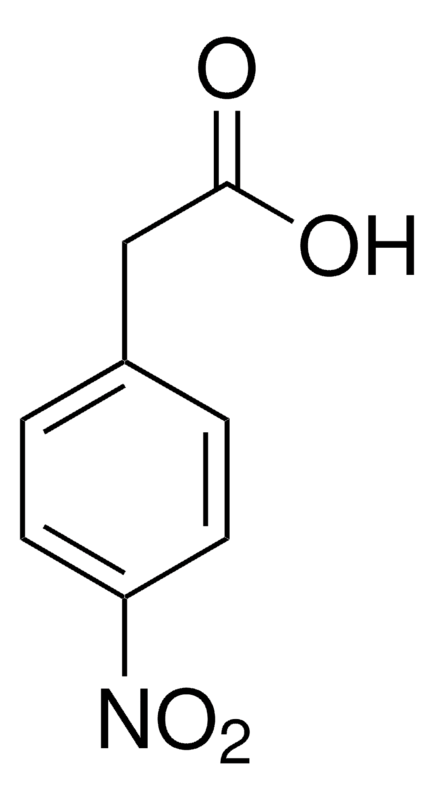4-Nitrophenylacetic acid CAS#: 104-03-0; ChemWhat Code: 22621
Identification
| Product Name | 4-Nitrophenylacetic acid |
| IUPAC Name | 2-(4-nitrophenyl)acetic acid |
| Molecular Structure |  |
| CAS Registry Number | 104-03-0 |
| EINECS Number | 203-168-5 |
| MDL Number | MFCD00007383 |
| Beilstein Registry Number | No data available |
| Synonyms | 4-nitrobenzeneacetic acid4-Nitrophenylacetic acid2-(4-nitrophenyl)acetic acidp-nitrophenylacetic acid |
| Molecular Formula | C8H7NO4 |
| Molecular Weight | 181.147 |
| InChI | InChI=1S/C8H7NO4/c10-8(11)5-6-1-3-7(4-2-6)9(12)13/h1-4H,5H2,(H,10,11) |
| InChI Key | YBADLXQNJCMBKR-UHFFFAOYSA-N |
| Canonical SMILES | O=C(O)Cc1ccc(N+[O-])cc1 |
| Patent Information | ||
| Patent ID | Title | Publication Date |
| WO2024/54881 | LIGAND-ENABLED SCALABLE C-H HYDROXYLATION OF BENZOIC AND PHENYLACETIC ACIDS AT ROOM TEMPERATURE | 2024 |
| CN116041196 | Novel method for catalytic synthesis of amido bonds | 2023 |
Physical Data
| Appearance | Pale yellow needle-shaped crystals |
| Solubility | slightly soluble |
| Flash Point | No data available |
| Refractive index | 1.5468 (estimate) |
| Sensitivity | No data available |
| Melting Point, °C | Solvent (Melting Point) |
| 153 – 155 | |
| 153.69 | methanol |
| 140 – 142 | |
| 146 – 148 |
| Description (Boundary Surface Phenomena (MCS)) | Solvent (Boundary Surface Phenomena (MCS)) | Temperature (Boundary Surface Phenomena (MCS)), °C |
| Surface tension | H2O | 22 – 25 |
Spectra
| Description (NMR Spectroscopy) | Nucleus (NMR Spectroscopy) | Solvents (NMR Spectroscopy) | Original Text (NMR Spectroscopy) |
| Chemical shifts | 1H | dimethylsulfoxide-d6 | 1H NMR (DMSO-d6, 400 MHz): δ ppm, 12.59 (s, 1H), 8.193 (d, J = 8.8 Hz, 2H), 7.56 (d, J = 8.8 Hz, 2H), 3.79 (s,2H). |
| Chemical shifts, Spectrum | 1H | chloroform-d1 |
| Description (IR Spectroscopy) | Solvent (IR Spectroscopy) |
| Bands | potassium bromide |
| Intensity of IR bands, Bands, Spectrum | potassium bromide |
| Bands | neat (no solvent, solid phase) |
| Description (UV/VIS Spectroscopy) | Solvent (UV/VIS Spectroscopy) | Absorption Maxima (UV/VIS), nm |
| Spectrum | 257, 325 | |
| water | 291 | |
| diethyl ether | 264.978 |
Route of Synthesis (ROS)
| Conditions | Yield |
| With lithium aluminium tetrahydride In diethyl ether at 50℃; for 3h; Temperature; Inert atmosphere; | 96.5% |
| With chloro-trimethyl-silane; indium(III) bromide; 1,1,3,3-Tetramethyldisiloxane In chloroform at 60℃; for 1h; Inert atmosphere; | 75% |
| With dimethylsulfide borane complex In tetrahydrofuran at 20℃; for 1h; |
Safety and Hazards
| Pictogram(s) |  |
| Signal | Warning |
| GHS Hazard Statements | H315 (94.4%): Causes skin irritation [Warning Skin corrosion/irritation] H319 (93.3%): Causes serious eye irritation [Warning Serious eye damage/eye irritation] H335 (93.3%): May cause respiratory irritation [Warning Specific target organ toxicity, single exposure; Respiratory tract irritation] Information may vary between notifications depending on impurities, additives, and other factors. |
| Precautionary Statement Codes | P261, P264, P264+P265, P271, P280, P302+P352, P304+P340, P305+P351+P338, P319, P321, P332+P317, P337+P317, P362+P364, P403+P233, P405, and P501 (The corresponding statement to each P-code can be found at the GHS Classification page.) |
Other Data
| Transportation | NONH for all modes of transport |
| Under the room temperature and away from light | |
| HS Code | 290621 |
| Storage | Under the room temperature and away from light |
| Shelf Life | 1 year |
| Market Price | USD |
| Druglikeness | |
| Lipinski rules component | |
| Molecular Weight | 181.148 |
| logP | 1.341 |
| HBA | 2 |
| HBD | 1 |
| Matching Lipinski Rules | 4 |
| Veber rules component | |
| Polar Surface Area (PSA) | 83.12 |
| Rotatable Bond (RotB) | 3 |
| Matching Veber Rules | 2 |
| Use Pattern |
| Mainly used as intermediate of atenolol or other organic synthesis. |
Buy Reagent | |
| No reagent supplier? | Send quick inquiry to ChemWhat |
| Want to be listed here as a reagent supplier? (Paid service) | Click here to contact ChemWhat |
Approved Manufacturers | |
| Want to be listed as an approved manufacturer (Requires approvement)? | Please download and fill out this form and send back to approved-manufacturers@chemwhat.com |
Contact Us for Other Help | |
| Contact us for other information or services | Click here to contact ChemWhat |

